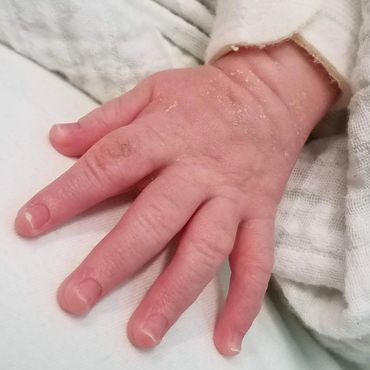About Marshall-Smith Syndrome ("MSS")
What is MSS?
Overview
Marshall-Smith syndrome (MSS) is an ultra-rare, genetic disorder that causes multiple congenital anomalies. MSS was first described in 1971 by physicians R.E. Marshall, C.B. Graham, C.R. Scott, and D.W. Smith. Since then, fewer than 100 cases have been described in worldwide medical literature.
The syndrome is characterized by its most common features, including:
- Advanced bone maturation, visible on a hand and wrist x-ray;
- Distinct facial features: prominent forehead, shallow eye sockets, sunken nose bridge, sclerae (whites of the eyes) are a bluish color, undersized jaw;
- Difficulty breathing and eating, leading to poor growth and nutrition;
- Moderate to severe intellectual and physical disabilities.
In typical development, bones mature through several stages, and the skeletons of infants and young children have more cartilage than those of an adult. One of the hallmark features of MSS is accelerated skeletal maturation. Throughout infancy and early childhood, the hand and wrist bones of a child with MSS look much more developed on x-ray than is expected for their chronological age ("advanced bone age"). Early on, other syndrome-specific skeletal anomalies are commonly seen, including a narrowed upper part of the rib cage, large hands and feet, flexed great toes, and bullet-shaped fingers.
The size of babies at birth is usually typical for gestational age, but growth slows dramatically in early childhood, thus, adolescents and adults are significantly smaller than expected for their age. Average adult height can sometimes be difficult to measure with certainty, as most with MSS develop scoliosis and/or kyphosis. On average, final adult height is estimated to be around 51-55 in (130-140 cm). Head size can be larger than usual (macrocephaly) in infancy and early childhood, but this is not typically an issue into adulthood.
Specific facial features in MSS typically include a prominent forehead, protruding and widely spaced eyes, an undersized chin, and a small, upturned nose. Those with MSS tend to look very similar to one another because of these distinct facial features. Commonly, the middle of the face is underdeveloped causing issues with the nasal passages and upper airway. There are often also problems with “floppy” tissue in the back of the throat (larynx), which can impact breathing and eating. In addition to the facial features, excessive hair growth (hypertrichosis) is common.
Significant physical and intellectual disabilities almost always occur in MSS. Young children may take longer to develop gross motor skills like crawling or walking. Speech is limited and sometimes absent, though alternative forms of communication such as gestures, sign language, and electronic devices are effective.
It is important to remember that no two patients with MSS will have the exact same clinical manifestations, and even specific symptoms can have a wide range of severity. Children and adults with Marshall-Smith Syndrome tend to be quite happy and outgoing despite their challenges.
Note: MSS is not synonymous with Marshall syndrome, which is a completely different genetic disorder.
Prevalence and Demographics
Fewer than 100 cases have been reported in the worldwide medical literature to date, which makes the prevalence less than one in one million births. It appears to be present across the world, affecting males and females equally.
Diagnosis
Historically, all individuals with MSS have been diagnosed through a careful physical examination and study of their medical history. This clinical diagnosis can now be confirmed by testing for a change in the gene NFIX. There are several genetic testing options available; whole exome studies are not always necessary.
If a physician suspects Marshall-Smith Syndrome, they may obtain a hand and wrist x-ray of the patient to assess bone age. Advanced bone age is always seen in Marshall-Smith Syndrome, but it may also be present in other genetic syndromes. A full skeletal x-ray survey may be done to assess any other potential dysostosis or anomalies.
Prognosis
Marshall-Smith Syndrome was long considered a disease of childhood because affected individuals did not typically survive past three years old. Thanks in large part to modern medical technology and expectant, aggressive treatment of breathing and feeding problems, many children with MSS are surviving well into adulthood. As of this writing, MSS-USA is aware of more than 25 individuals between the ages of 0 and 45 years old living with MSS in the United States. It is a primary goal of the Marshall-Smith Syndrome Organization of the USA, Inc. to provide resources, encourage research, and advocate for treatments that improve and extend the lives of those living with MSS around the world.






Marshall-Smith Syndrome Organization of the USA
Copyright © 2025 Marshall-Smith Syndrome Organization of the USA, Inc. - All Rights Reserved.